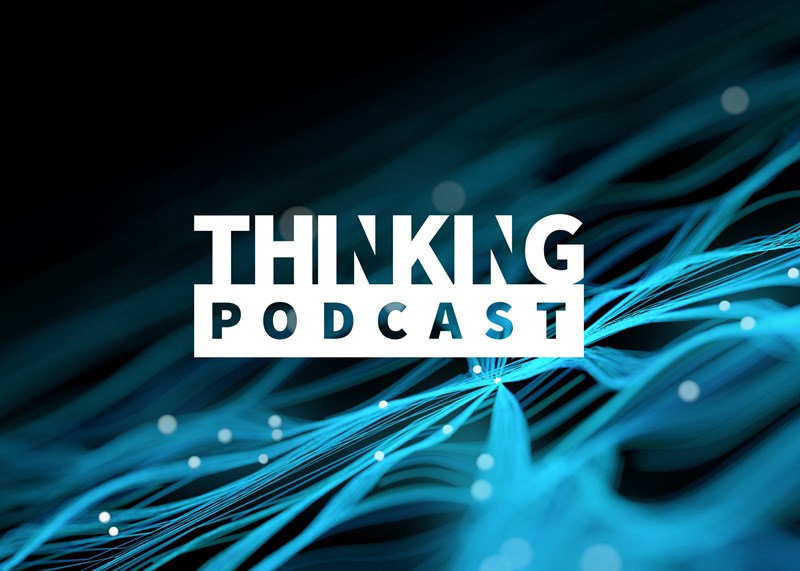In this episode of William Blair Thinking Presents, technology analyst Maggie Nolan, partner, CPA, dives into the latest trends in IT services, exploring the impact of generative AI, data infrastructure, and political influences on the industry.
Podcast Transcript
00:05 - 00:29
Chris T
Welcome to William Blair Thinking Presents, the podcast series that aims to provide in-depth expertise from our award-winning equity research and capital advisory teams on today's financial and economic landscape. I'm Kristen, head of equities, marketing media relations, and I'm delighted to be your host. Hey everybody. Today is January 23rd, 2025. On today's episode of William Blair Thinking Presents, we welcome Maggie Nolan.
00:29 - 01:09
Chris T
She is a partner in Equity Research analyst covering IT services companies. Her and her team recently released a periodical called We're On It, On It Being It, which aims to highlight the most talked about trends affecting their covered companies and industries. It's basically a quicker view of subjects that have gained recent traction in the news at industry events, during discussions with the companies and so forth, and I thought it was worth inviting her to talk through the report, which for this one covers a range of topics, including how gen AI is impacting IT budgets, the data opportunity for IT services providers, thoughts on Doggy's potential impact on the industry, and so forth.
01:09 - 01:21
Chris T
So, Maggie, welcome to kick things off. Can you provide maybe a little more context around what the periodical is? And then from there, I figured we could walk through some of the key takeaways.
01:21 - 01:56
Maggie N
Sure. Thanks, Chris, for having me. And, yes, the periodical has a lot in it. So the point of it is to really capture the hot topics of the moment in IT services. So it's informed by our recent research, whether that's travel with companies, conferences we've attended, interesting news flow. We found other articles. We try to triangulate it into a concise and easy-to-consume series of topics for our readers.
01:56 - 02:28
Maggie N
And there are a couple of recurring sections in there as well, like an aggregation of M&A in our coverage. We have a Stocks to Highlight section. And those highlights can be, you know, a topic at the moment, a company that just hosted an event or a conference, really anything that we deem worthy of a call out. We just published volume number 15 and some of those key topics, as you outlined, are AI and generative AI in particular.
02:28 - 02:59
Maggie N
We saw a slowdown in services spend last year, but we think 2025 looks better for the group, including some generative AI-related opportunities to drive revenue. So mid to long term AI services, we think, are going to become an extension of digital transformation. And that wave that really drove the growth for this group over the last, you know, more than a decade.
03:00 - 03:18
Maggie N
So the other kind of big piece of the report is some of the political hot topics that are impacting sentiment on IT services. You know, the big takeaway there is we're actually not too concerned with any of those topics, but we can get into some of the details in a bit.
03:18 - 03:41
Chris T
All right. Well, first and foremost, let's talk about Gen. AI seems to be a pretty core theme across the report. One question you posed at the beginning is if Gen AI has been eating away at IT budgets, and it's something you say is but it just tough to track, given enterprises have not made significant strides in determining the value and applicability of this technology.
03:42 - 03:49
Chris T
So that said, can you provide some analysis around this question? And I think it's worth going through some of the key takeaways in that regard.
03:50 - 04:32
Maggie N
So we've seen this before and other technology waves. There's a shift in priorities of where dollars should go and spending right now on the infrastructure layer to prepare for generative AI is definitely taking precedent over other parts of the IT budgets, and it has been for a couple of years. So in the report, we talk about for our coverage of IT services, these companies have seen a material slowdown in spending on their services on areas like application development, for instance, as a result of this reprioritization.
04:32 - 05:01
Maggie N
And I think, Chris, this is compounded by the inability for budget holders at enterprises and, you know, C-suite to calculate a realistic ROI on what projects and products that include AI or generative AI, is going to be. And so they've never done this before. They don't know how to quantify it, and they're reluctant to make a decision because of that.
05:01 - 05:30
Maggie N
So it's been a slow couple of years in terms of growth. As you know, all of these enterprises digest this foundational spend, push through maybe smaller scale proofs of concepts. But the good news is IT services companies and some of the bellwethers in this space are starting to point to more of these projects moving into production at scale, particularly if there is vertical expertise involved.
05:30 - 05:38
Maggie N
And then we think there are even near-term opportunities around kind of infrastructure and data, where these companies are picking up more and more work as well.
05:38 - 05:56
Chris T
A little further down the report, you mentioned that data, specifically, an immature data foundation tends to be a common hurdle for enterprises hoping to use gen AI. Why is a strong data foundation a requirement for gen AI? And what services are providers offering to help build this foundation?
05:56 - 06:30
Maggie N
Absolutely. We are pretty bullish on the role of IT services companies in aiding their clients enterprises with, you know, having a strategy around their data infrastructure and structure. So this is, like you said, foundational to the use of generative AI. And it's actually a pretty simple concept really for the data, which is if you put garbage in, you get garbage out.
06:30 - 07:07
Maggie N
If you don't want to do an analysis of bad data, you're going to get inaccurate results and recommendations. And so this is really paramount to companies preparing for actually using generative AI on a regular basis. And so there's a lot that we think IT services companies can offer here. There's, you know, at the very tip, data strategy and consulting, there's master data management, data organization structuring, preparation and cleansing.
07:07 - 07:29
Maggie N
I mean, we could go on and on of all the different kind of SKUs of work here, but it's also very closely tied to things like data modernization and migration, which is intertwined with an organization's cloud strategy. So yeah, I threw a lot of words at you there, but it just means there's a lot of work to be done, right?
07:29 - 07:56
Maggie N
Sure. And there is a really prominent company in this IT services space and has put out some research on this, and they've shown statistics like, only 40% of workloads are in the cloud today. And, you know, maybe 20% of those have actually been optimized. 10% of companies have actually completed the necessary data work to use generative AI.
07:56 - 08:09
Maggie N
So we're pretty optimistic that there's an opportunity here for these companies to have really robust service offerings and pick up a lot of the spending around this with their client bases.
08:09 - 08:23
Chris T
Such, the change in administration, the kind of exposure your sector has, the federal government, you mentioned there is a risk that increased scrutiny of federal contracts could lead to pricing pressures. Can you expand on that one really quick?
08:23 - 09:03
Maggie N
Sure thing. So the volume had a couple of politically focused topics, which obviously makes sense as you have a new administration coming in. And, you know, the federal government piece is really in response to the initiatives, the DOJ's initiatives to cut a lot of the fat and make the government more efficient. And so we run through the actual exposure figures to the federal government in the report within my coverage universe.
09:03 - 09:35
Maggie N
Overall, it's pretty minimal because I don't cover the actual vendors that tend to serve the federal government. But there is, you know, a portion of revenue from several of our providers that is exposed to the federal government and what we're trying to lay out in the report is we're acknowledging that in a cost-cutting environment, there's a risk that pricing on contracts is going to come under pressure.
09:35 - 10:09
Maggie N
We think it's less likely on existing contracts versus future contracts. But the point that we're really trying to drive home in the report is that while that risk exists, the technology companies and these IT services companies that serve the federal government are actually the ones that are bringing innovation and efficiency to the federal government. So they're involved in critical areas of technology, infrastructure.
10:09 - 10:38
Maggie N
They're often playing a big role in security from a couple of different angles. So really, all things considered, we don't feel like spending on IT services is where, you know, DOJ's likely to spend its time trimming. If anything, they're probably going to want technology like automation projects, for instance, to help actually achieve some of their spending cuts and goals that they've laid out.
10:38 - 10:59
Chris T
Got it. So the report also briefly touches on the trust and safety industry, which you say is an industry experiencing fast growth and one that service providers are poised to benefit from as companies from a wide variety of industries have in-house practices or outsource work to keep users safe on their digital platforms. As obviously your words, not mine.
10:59 - 11:04
Chris T
So can you talk about the evolution you're seeing in this industry?
11:04 - 11:35
Maggie N
Of course. So this is another one of those sort of politically charged topics that's impacting the industry. And the reason for that is a slice of what we call trust and safety work includes the moderation of content on digital platforms. So what does that mean? Think of a basic example of that as a company that's hired to remove inappropriate content from your favorite social platform.
11:35 - 12:13
Maggie N
And what we've seen is that the markets tend to respond to any data point that indicates one way or the other. You know, towards the question of will the current political climate support more or less of that content moderation? And then they trade the stocks accordingly. But in this report, we're really trying to look at some of the more kind of fundamental drivers of trust and safety, including that slice that is content moderation.
12:13 - 12:46
Maggie N
And so we kind of come to the conclusion that despite all of this noise, there are some underlying catalysts here that make this a pretty interesting point in time in the evolution of this industry. One increased scrutiny of trust and safety work and, you know, changing regulations is going to just make it more complicated in general for platforms to be certain that they are doing this work properly.
12:46 - 13:36
Maggie N
And what do you do when things get more complex? Well, oftentimes you bring on a partner that you can consult with on the work. And these would be partners like our covered companies that have trust and safety services practices to content production on platforms is still growing rapidly. And we're creating content right now. Right. Even if that percentage that you moderate might decline based on specific policies or regulations, the overall pie is still growing and we outlined that there are a couple of catalysts that maybe this growth accelerates further generative AI content production is going to go up.
13:36 - 14:11
Maggie N
Even more. Make that pie grow faster and larger. And the complexity of that content is going to increase, too. You know, we're producing audio content right now, but there's, you know, a whole kind of host of incremental content, you know, think of if metaverse takes off those types of things and the overall complexity is going to be influenced by things like deepfakes and trying to parse through what's real and what isn't.
14:11 - 14:35
Maggie N
So you have that increase in content and that increase in complexity of the content that we think is a tailwind for the industry. And then third, I would say trust and safety teams are just kind of doing a better job of being more innovative. In terms of the tools they use, demonstrating their value to their clients.
14:35 - 14:57
Maggie N
And so when you put all those things together, despite some of the noise about whether or not, you know, content should be moderated, there is a really, a lot of kind of interesting forces that make this services sector still a viable one from a growth perspective.
14:57 - 15:12
Chris T
We only have time left for one more question. I thought it might be worth touching on the impacts visa exposure will have across the IT services industry. It's a section of the report, albeit a smaller section of the report. But can you walk us through that really quick.
15:12 - 15:43
Maggie N
Yeah. So we've got it in the report. We have some standalone pieces on it too that we've written previously that are linked within the report. So you can kind of go deep into this topic if you really want to. It's fairly complex, but really what it comes down to is, you know, people have differing opinions on immigration policy, and this is an important topic for the industry that may be influenced by policy changes.
15:43 - 16:17
Maggie N
And it's still, as of now, pretty uncertain what the outcome may be, what some of those policy changes may be. But, in particular, there are skilled work visas called H-1b visas, and those are often used by IT services companies, to bring to the states to serve clients, talented individuals with specific skill sets, often in emerging technology areas.
16:17 - 16:56
Maggie N
Under the premise that you can't find enough of that talent in the United States alone, and you need to bring more of these people over to meet the demand. And, some within the president's inner circle are proponents of this. Others are against it as part of their immigration policy. And so it's very uncertain. But in the report, what we're trying to do is give an initial sense of, you know, the number of visas that are out there, the exposure, although you can't really get a perfect answer to that from the data that the government has made available.
16:56 - 17:22
Maggie N
But we give you sort of a starting point to start to understand things. And then ultimately we lay out the facts that while we don't know what's going to happen, there are levers that these companies can pull to help protect themselves and their margins from increasing costs related to visas. So we talk about moving work offshore or incorporating more automation.
17:22 - 18:01
Maggie N
And it's really taken on a life of its own in social media with some prominent figures. And so we thought it was worth laying out kind of the puts and takes there. But ultimately we've seen this program come under scrutiny before in the first Trump term. And, you know, these companies were able to navigate the complexities, response and to potential increases and costs and all of those options, you know, remain available to them, despite the outcome of potential policy changes this time around.
18:01 - 18:15
Chris T
All right. Well, Maggie, thanks for joining us. That's all the time we've got for today. But for those interested in reading the report, you can now request a copy by reaching out to us at William blair.com slash. Contact us. Thank you for taking the time to be with us today.
18:15 - 18:18
Maggie N
Thank you Chris. Appreciate it.
18:19 - 18:35
Chris T
For more head to William blair.com/thinking where you can browse our library of whitepapers, market updates, webinars and other resources designed to provide actionable intelligence for emerging opportunities. If you like what you heard, share and subscribe wherever you get your podcast.



